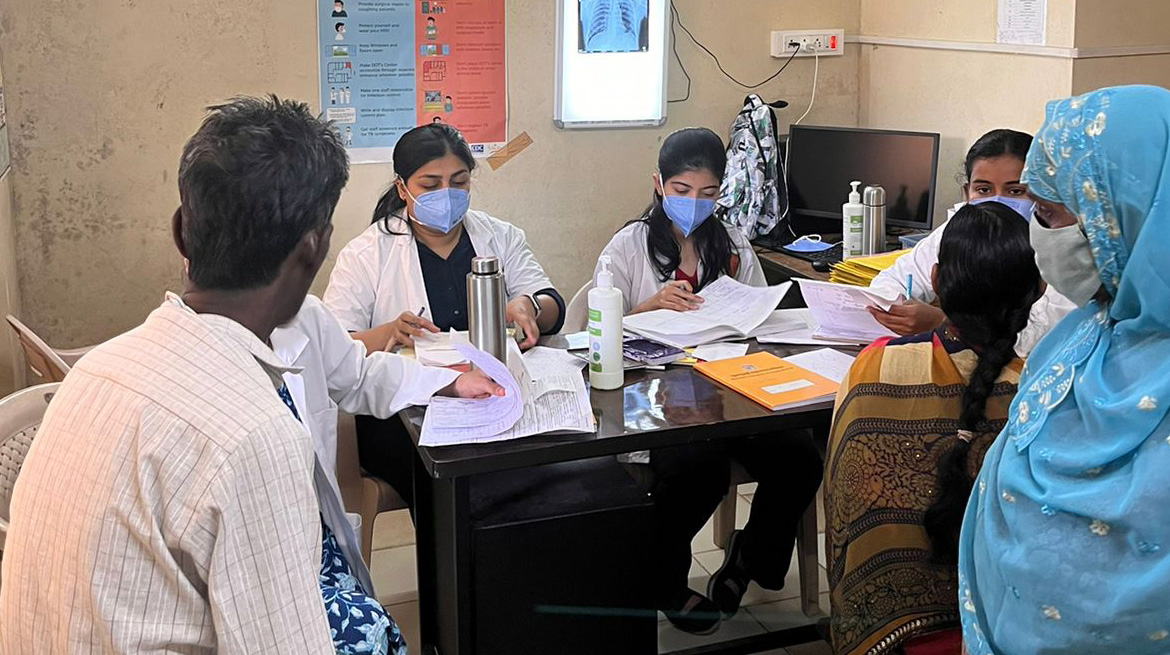“Tuberculosis is not just a medical problem, it’s a social disease.”
Former Director-General of the World Health Organization, Gro Harlem Brundtland, emphasized at the 30th Union World Conference on Lung Health in 2019 the enduring impact of tuberculosis (TB) on human health and well-being1. Despite decades of global efforts, TB remains a persistent challenge, as highlighted by the increasing number of cases reported in India in 2023, reaching a staggering 2,537,235. Alarmingly, the private sector, where a significant portion of TB patients seek care, contributes only a third of the total case notifications, indicating gaps in reporting and diagnosis2.
Observations from TB care in Mumbai’s slums highlight the intricate challenges of diagnosis and treatment. One patient, referred by a private practitioner, arrived at the clinic with a Chest X-ray and a blood-stained handkerchief, along with a hastily written note detailing his history. Working in cramped conditions with others, he had been experiencing non-specific symptoms for a month. Despite the simplicity of his case, the private practitioner merely ordered a chest X-ray and directed him to a public facility, missing the opportunity for basic management. Delays in seeking care, compounded by a lack of counselling and transportation barriers, underscored the importance of comprehensive diagnostic strategies and patient tracking to minimize delays in TB treatment.
Another difficulty faced is the radiologist’s approach and clinicians’ approach differing significantly while reporting the findings of a chest X-ray leading to misdiagnoses. Introducing an AI-based tool which can be handy even in resource-poor settings to standardise reporting can help reduce man-made errors.
Similarly, encounters with multidrug-resistant (MDR) TB patients underscore the urgent need for holistic, community-based TB palliative care initiatives. Lost to follow-up and unable to tolerate medications, these patients are left without essential end-of-life care, exposing systemic gaps in the provision of comprehensive TB services. A community-centred approach, addressing not only TB treatment but also the broader needs of patients, is essential to mitigate the devastating impact of TB on vulnerable populations.
Moreover, the intersectionality of TB with other health issues, such as nutritional deficiencies and menstrual irregularities among young women, highlights the diverse manifestations of TB morbidity. Insufficient programmatic provisions for surgical interventions related to urogenital TB and secondary infertility underscore the need for gender-sensitive TB care initiatives that address the unique needs of affected populations comprehensively.
However, the availability of essential diagnostic resources, such as CBNAAT cartridges, remains a pressing concern, disrupting the continuity of TB control programs and potentially leading to missed diagnoses. Ensuring smooth access to diagnostic tools is paramount to maintaining the efficacy of TB control efforts and safeguarding patient outcomes.
In an insightful conversation with a former DTO, who underscored the socioeconomic dimensions of TB, financial stability plays a pivotal role in patients’ motivation to adhere to treatment. This boosts their willpower and gives them hope for a stable disease-free future.
The District-level Maternal Death Review meetings have shed light on some new dimensions of the impact of Tuberculosis (TB) as it remains a significant indirect but preventable cause of maternal mortality. In some cases, despite patients displaying signs and symptoms suggestive of TB, their post-mortem reports reveal definitive signs of the disease. This indicates a failure in primary TB screening during antenatal care (ANC) visits, where relevant history, including exposure to TB and screening, should have been conducted. While the deaths might be deemed non-preventable at the tertiary level, they are undoubtedly preventable at the primary level through improved screening protocols, pre-conception counselling for women with a history of TB, and active TB screening. Moreover, another alarming revelation pertains to the inadequate assessment of medical fitness among women undergoing in vitro fertilization (IVF). Post-mortem reports of some of these women suggest the presence of TB foci.
Misdiagnoses and lack of appropriate decision-making in a clinical setting even for an age-old disease like tuberculosis can be attributed to the fact that clinical acumen takes years to build up and tends to follow conventionalism over guidelines. Hence conventional clinical decision-making also tends to stand between newer comprehensive steps of screening3. Promotion and integration of evidence-based medicine in the medical curriculum can help to build realistic clinical acumen.
Some incredible innovative approaches are being tried out and are showing promising results in terms of outcomes and their replicable models. For eg. some of Tamil Nadu’s innovative TN-KET initiative, launched in April 2022, aims to reduce TB mortality rates by implementing “Differentiated care strategies”. By triaging patients based on three key conditions – severe undernutrition, respiratory insufficiency, and inability to stand without support – the program quickly identifies and refers severely ill TB patients for comprehensive assessment and immediate admission to healthcare facilities. Spearheaded by the National Institute of Epidemiology and the State TB Cell, the initiative has already achieved significant success, with early TB deaths decreasing from over 600 to less than 350 within two months of diagnosis. Through meticulous triaging and targeted admissions, the program has identified and admitted nearly 3,300 severely ill TB patients for inpatient care, significantly improving their chances of survival. With ongoing efforts to enhance the quality and duration of inpatient care, TN-KET aims to further reduce TB mortality and improve outcomes for patients across Tamil Nadu3.
While advancements in TB diagnosis and treatment have been made, critical areas such as the development of an adult TB vaccine, access to newer therapeutic agents, and improvements in diagnostics remain under-addressed. India’s leadership role in the G20 presents an opportunity to catalyse global action towards ending TB by 2030, leveraging its capabilities in vaccine development and fostering innovation in diagnostics and therapeutics. With concerted efforts and strategic investments, there is hope for a future free from the burden of TB4.
References:
-
- Dr Gro Harlem Brundtland Director-General Elect The World Health Organization Speech to the Fifty-first World Health Assembly Geneva, 13 May 1998
- https://www.thehindu.com/sci-tech/health/india-achieved-record-tb-notification-in-2023/article67734558.ece
- https://www.thehindu.com/sci-tech/science/tamil-nadus-novel-initiative-results-in-reduced-tb-deaths/article66631322.ece
- https://www.thehindu.com/opinion/lead/a-new-edge-to-the-fight-against-tuberculosis/article66760902.ece




